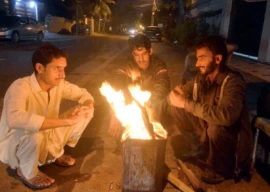
Asking architect Shahid Abdulla to choose his best work is a tough call. He has helped design complex structures like the MCB Tower, Dolmen City and Kidney Centre. But when someone asked him to name the project he would love to talk about the most, he took seconds to reply: public toilets.
“For an architect, public toilets are the most difficult thing to design,” he said. “These are the most used and abused places. We have to worry about vandalism, pilferage and stolen taps.”
Abdulla, a director at Arshad Shahid Abdulla Pvt Ltd, became part of an ambitious project in 1999 when a group of concerned citizens decided to build public toilets throughout Karachi.
While 200 toilets were planned, only 56 were built at sites including City Courts, Nipa Chowrangi, Jehangir Park, Polo Ground, the Jinnah and Civil hospitals and Boat Basin. A petition was submitted in the Sindh High Court last week, noting 78 parks and shopping areas with no public lavatories.
Surprisingly, several of these have survived instead of meeting the usual fate of ambitious city projects. They are cleaned every day and people use them at a cost of Rs5.
Rizwan Malik sells fruits from a pushcart stall in Saddar. He uses one of the toilets at Jehangir Park at least four times a day. “There is a mosque that I go to as well. But all sorts of people use that and the stench is bad.”
Paying Rs5 per visit is not a bad deal, he said. “It would have been better if there was soap to wash my hands.”
The caretaker Ghani Masih collects the money and washes the water-closets every two hours. “At least 150 people come to use it every day. Shoppers come as well but conductors, drivers and shopkeepers from the nearby markets are regulars.”
Stopping vandalism has been difficult. “Despite the locked gates, at night people take away the washbasin, taps and even the lota (water pots),” Masih laughed.
Design
Several high-profile names were behind the project. MCB Bank’s former president Hussain Lawai had asked Shahid Abdulla to design the toilets. He was given a budget of Rs150,000 per facility.
A great deal of thought went into it. The toilets had to be easy to transport and build. Durability was key.
It took almost a year for the design to be completed and approved by then Sindh Governor Mohammadmian Soomro, who inaugurated the first toilet in Jehangir Park.
“It was designed in a honeycomb shape. Such a structure don’t take much time to be erected and can be easily extended,” he said.
“The RCC panels were designed like Lego,” Abdulla said. “They were light so that one labourer could easily pile one over the other. We saved the cost of cranes and machinery.”
The sewerage pipes had a large diameter and were short in length – just two feet, he said. “The idea was to prevent frequent clogging. It could easily be clean if someone throws garbage and sanitary napkins.”
There is an overhead water tank over each toilet which is refilled every few days.
Female misery
Architect Abdulla grew up in Karachi and recalls that he would use the public facilities at Bunder Road. “But where would a woman go now?” he wondered. “She does not have the choice to use a mosque or a McDonald’s.”
While men can easily use the public toilets or the sidewalks without any repercussions, women have few options and suffer as a result. Gynaecologist Dr Nusrat Khan says, “When women don’t urinate for long, it causes urinary retention.”
Waiting to use a bathroom damages the bladder and can lead to kidney failure in extreme cases. “Women often suffer from urinary tract infections,” Khan said. Additionally, women are also prone to catching diseases more quickly than men if toilets are dirty, she said.
Published in The Express Tribune, April 24th, 2012.



1725030039-0/Untitled-design-(2)1725030039-0-165x106.webp)
1725366721-0/kyle-(1)1725366721-0-165x106.webp)
1732697578-0/Untitled-design-(5)1732697578-0-270x192.webp)











COMMENTS
Comments are moderated and generally will be posted if they are on-topic and not abusive.
For more information, please see our Comments FAQ